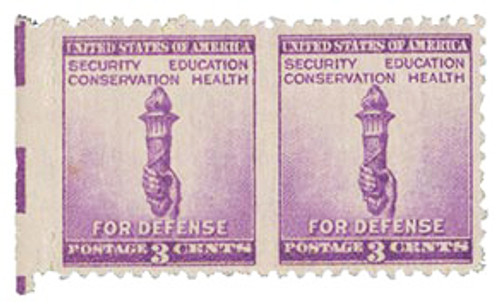U.S. #899b- Horizontal Pair
1¢ Statue of Liberty
National Defense Issue
Issue Date: October 16, 1940
City: Washington, D.C.
Quantity: 6,081,409,300
Printed by: Bureau of Engraving and Printing
Printing Method: Rotary Press
Perforations: 11 x 10.5
Color: Bright blue green
U.S. #899 was the first in a 3-stamp series issued to raise consciousness of the need for a strong national defense, which President Franklin Roosevelt considered especially important as World War II raged in Europe. The stamp pictures the Statue of Liberty that was placed on top of fort built to defend New York against naval attacks.
The Defense Trio of 1940
By the summer of 1940, Americans wanted nothing to do with the European conflicts overseas, holding tightly to their isolationist ideals. The only aid President Franklin Roosevelt could provide (as Congress refused to pass any military bills) was repealing the arms embargo to allow the U.S. to sell arms to Great Britain. Britain was required to pay in advance and transport the material back on their own. However, German ships sank them almost as fast as the weapons were produced.
Roosevelt realized it was only a matter of time until Adolf Hitler would narrow his focus on the Western Hemisphere, and felt it was his duty to prepare the nation for when that time came. Roosevelt’s first action to put an end to the American isolationism was trading 50 old ships for 99-year leases on strategic bases throughout the Atlantic, which would protect American interests. This began to sway the American opinion on the situation.
The next step to Roosevelt’s plan was to issue postage stamps to educate the public. He provided sketches of what he envisioned to the Post Office Department, and the final designs stayed true to the President’s vision. When the stamps were issued, many more Americans supported the importance of preparedness and the stamps served as a constant reminder of the importance of a strong national defense.
The Statue of Liberty
French politician and writer Édouard René de Laboulaye was one of the first to suggest giving America a gift to mark the centennial of the American Declaration of Independence. French sculptor Frédéric Bartholdi designed the sculpture and Gustave Eiffel (designer of the Eiffel Tower) designed the iron pylon and skeletal framework of the statue.
To fund the statue, the people of France made public donations. Also, performances were used to raise money, including La liberté éclairant le monde (Liberty enlightening the world) by future famous composer Charles Gounod. In all, $250,000 was raised. Similarly, the U.S., which had agreed to build the statue’s base, held several benefit events, art exhibitions, auctions and prizefights to raise money.
Although Laboulaye initially planned to present the statue to America in 1876, a late start and several delays made this impossible. The right arm and torch were completed in time, and were put on display at the Centennial Exposition in Philadelphia. The statue was completed in France in 1884 and was dedicated on October 28, 1886 by President Grover Cleveland.
The statue was modeled in a classic roman style based on Libertas, the ancient Roman goddess of freedom from slavery, oppression, and tyranny. Lady Liberty’s right foot is raised, showing that she is not stationary, but moving forward. Her left steps on broken shackles, representing the American dream to be free from oppression and tyranny. Her crown of seven spikes represents the Seven Seas and the seven continents, while her torch symbolizes enlightenment. Lady Liberty holds a tablet that is representative of knowledge, and reads “July 4, 1776,” the date of the Declaration of Independence. Historians debate who Liberty’s face is modeled after, but it’s likely one of two women. Some believe it was Isabella Eugene Boyer, the recently widowed wife of Isaac Singer, creator of the Singer sewing machine. Others believe the statue was modeled after sculptor Frédéric Bartholdi’s mother, Charlotte Bartholdi.
FDR – The Stamp-Collecting President
President Franklin Roosevelt was instrumental in the design and issuance of U.S. #899. Franklin Delano Roosevelt’s mother introduced the future President to stamp collecting at a young age. Throughout his life, he turned to his collection to relax and unwind.
Roosevelt was elected President four times, serving in the nation’s highest office longer than any other chief executive – 12 years. During those 12 years, Roosevelt promoted the importance of stamps by personally approving each of more than 200 stamp designs. This included suggesting topics, rejecting others, and even designing some of the stamps himself. He used U.S. postage stamps to educate Americans about their heritage, to buoy war-weary spirits during World War II, and to send a message of peace and hope as Europe faced the overwhelming task of rebuilding.







